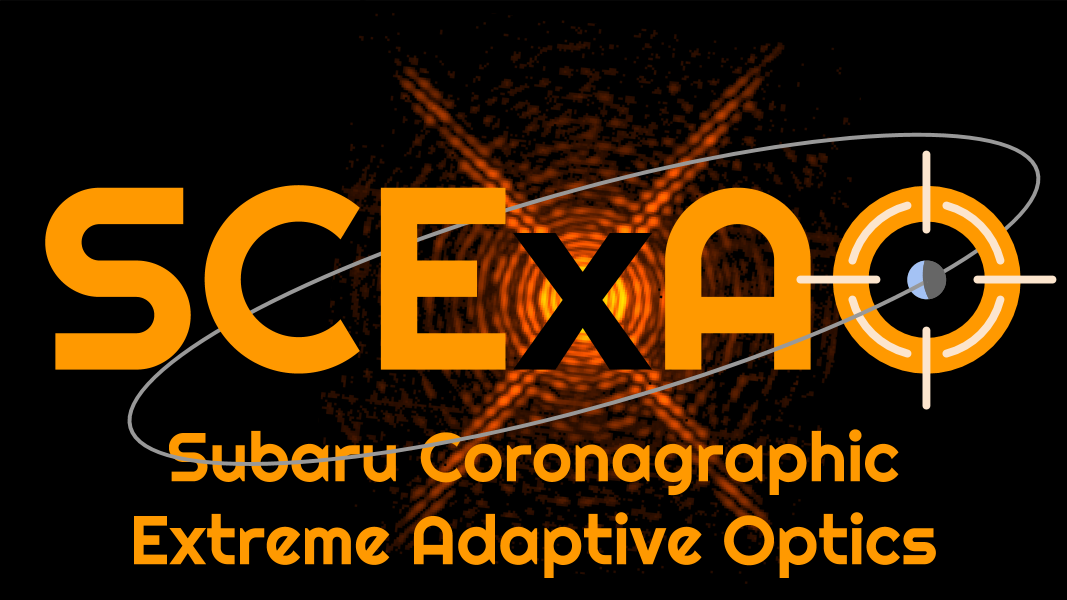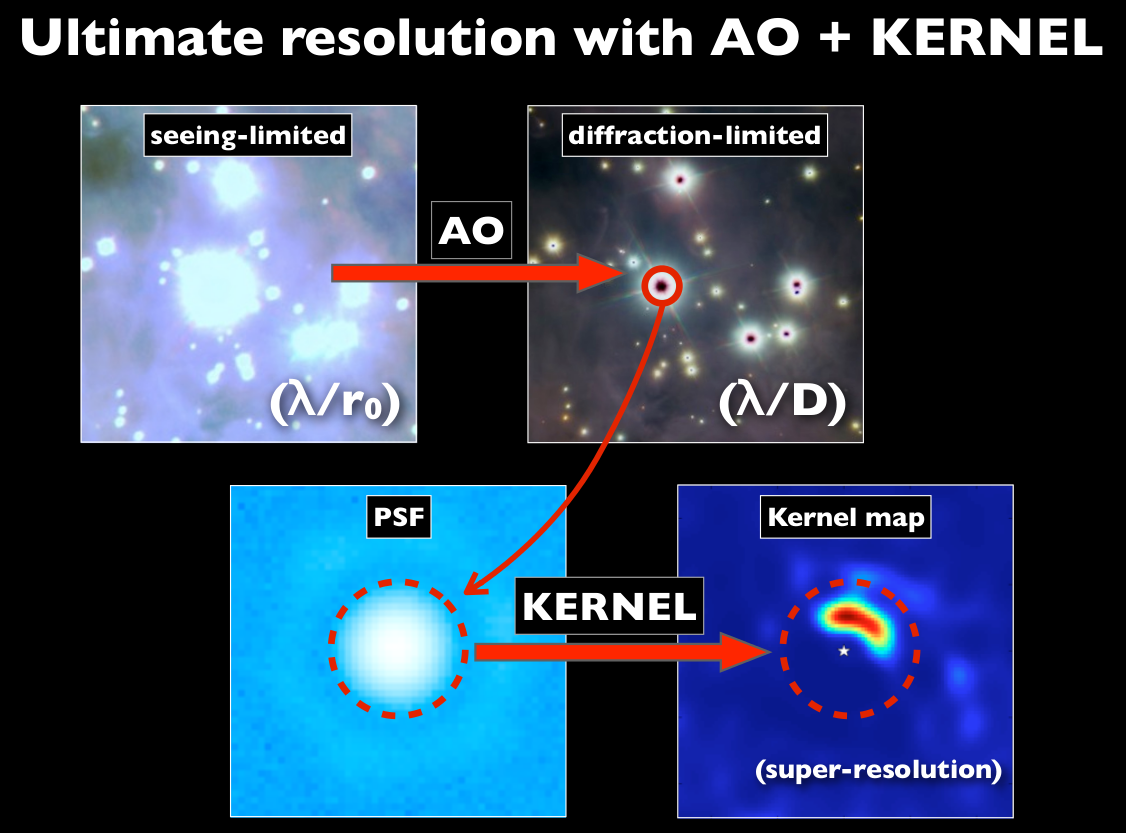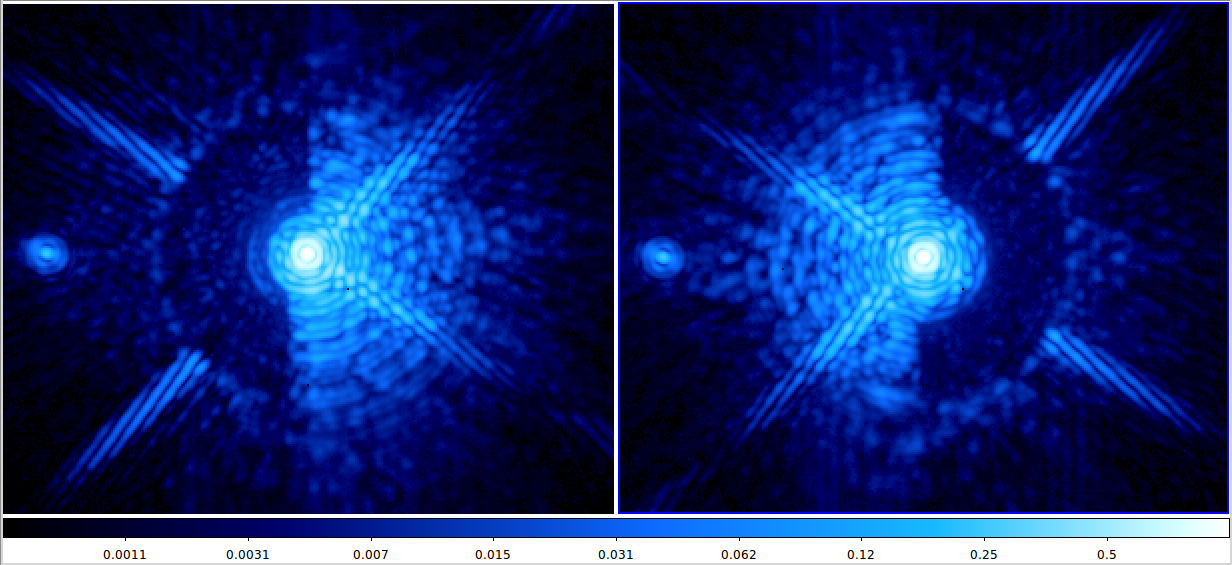
My research and activities in instrumentation are mostly relevant to high contrast and high angular resolution imaging. The long term goal is the direct imaging and characterization of extrasolar planets... but the techniques I develop have applications to general astrophysics!

The invention of the telescope, almost exactly 400 years ago, marked the beginning of modern astronomy. Since then, a deep connection has run between, on the one hand, the science and what we learn from the study of the heavens, and on the other hand, the observatories and instruments required to perform these observations. Often, the science has driven the development of improved instrumentation: it is for example steady work on the stabilization of high resolution spectrographs has made it possible to measure long term low amplitude RV signals, required to detect extrasolar planets. Sometimes however, observational breakthroughs have happened because of astute instrumental developments: Michelson's stellar interferometer, Lyot's coronagraph or Labeyrie's speckle interferometry; each of these have, in their time, opened the door to entirely new areas of science, by offering a new entry into previously unexplored regions of the 4D parameter space: position, wavelength and time (α, δ λ and t). One of the most outstanding developments of recent years, is the deployment of adaptive optics (AO) on large telescopes, that changed observations from seeing limited to diffraction limited. The consequences of this technique go well beyond the straightforward obtention of sharper images: it makes conventional instrumentation like imagers and spectrographs more efficient, and enables the use of new techniques, like stellar coronagraphy.One of its most exciting prospects of this technique remains the obtention of direct images of extrasolar planets, an ambitious scientific objective which has motivated most of my work on astronomical instrumentation.
While the field of extrasolar planet search has so far been dominated by indirect detection methods: radial velocity, photometric transits and microlensing events, the last few years have finally witnessed the production of direct images of alien worlds, starting with the planetary mass companion orbiting the brown-dwarf 2M1207, and more recently, planetary candidates around Beta Pictoris, HR8799 and Fomalhaut. Naturally following the discovery of each new extrasolar world comes the thrilling question of the possibility of it harboring life. The large number of exoplanet candidates announced by Kepler indeed suggest that rocky ``Earth-like'' planets are very numerous. The direct detection of planets in the habitable zone, even on nearby stars (30 parsecs) however remains a technical challenge, as angular separations range from ten to a few hundreds of milli-arc seconds, a limit that is dangerously close to the fundamental limit of diffraction of most existing visible/IR telescopes. My research is focused on the development of high angular resolution instrumentation and techniques that expand the extrasolar planet discovery space toward high contrast and small angular separation; as well as on the interpretation of the often unique data that is produced in the process. The products of such observations include the characterization of a wide range of low-mass objects in multiple systems: cold stars, brown dwarfs and of course, extrasolar planets. Direct imaging of extrasolar planets orbiting main sequence stars requires high-contrast, of the order of 105-106 in the near infrared for young Jovians, and all the way up to 1010 in the visible for Earth-like planets, and this, at the diffraction limit. To tackle this dual contrast/angular resolution challenge, two families of complementary techniques are being used: coronagraphy and interferometry, the study and use of which I actively pursue.

The acronym SCExAO stands for Subaru Coronagraphic Extreme Adaptive Optics. It is the name of an instrument currently installed at the IR Nasmyth focus of the Subaru Telescope, a major astronomical observing facility of the National Astronomical Observatory of Japan, atop the Mauna Kea summit, on the beautiful island of Hawaii. It is an instrument dedicated to high-contrast imaging, the kind that attempts at revealing the direct environment of nearby stars... in particular the extrasolar planets that they sometimes host.
Developed as instruments like SPHERE and GPI were assembled, SCExAO is a more daring approach to high contrast imaging, focusing on the smallest angular separations. The best way to learn about SCExAO is to visit the project webpage.
SCExAO is a fantastic platform for experimentation with high angular resolution imaging techniques: coronagraphy, interferometry and auxilliary tricks like wavefront control. On special interest to me are the application of the asymmetric pupil Fourier wavefront sensor I developed and other focal plane based wavefront control techniques like speckle nulling.

Project KERNEL is funded by the European Research Council (ERC) under the European Union's Horizon 2020 research and innovation programme (grant agreement #683029).
Astronomy requires large telescopes to improve the sensitivity and the angular resolution of its observations. Of these qualities, angular resolution is the most difficult to maintain in the optical and near-infrared, since the atmosphere reduces it to that of a 10 cm aperture, regardless of the telescope size. On the one-hand, Adaptive Optics (AO) actively compensates for this effect but the improvement is often partial only. On the other hand, interferometric techniques (most notably sparse aperture masking interferometry) passively allow the extraction of self-calibrating observables, that boost the angular resolution, but severely affect the sensitivity of observations.
The KERNEL project will enable every optical telescope equiped with AO to reach its ultimate angular resolution potential at full sensitivity, using a Fourier-phase framework, with applications ranging from the reinterpretation of archival science data to the development of wavefront control strategies for the giant segmented aperture of large telescopes like the space-borne JWST, or the upcoming generation of ground based extremely large telescope (ELTs).
KERNEL will achieve this objectives thanks to:
That will require the combined development of:
The consequences of this project will have a major impact on the design and scientific exploitation of future high angular resolution instrumentation on the existing generation of 8-10 meter class telescopes as well as on the upcoming generation of 30-40 meter giants, championned by Europe and its E-ELT.
Starting October 1, 2016, KERNEL is going to lead to the opening of a postdoctoral research position as well as to a PhD project. The details regarding the application process are going to be advertised soon.
